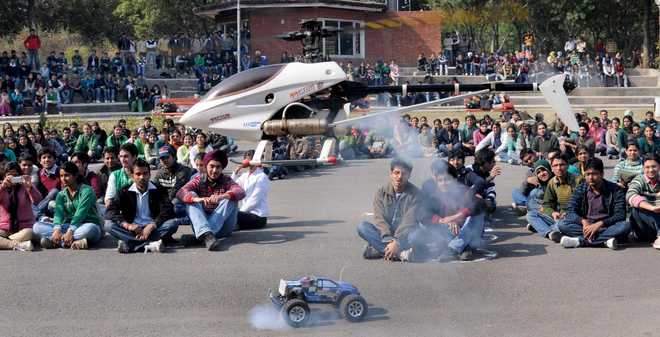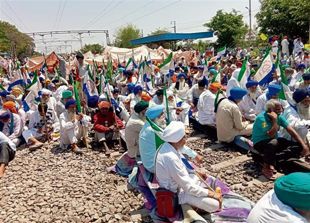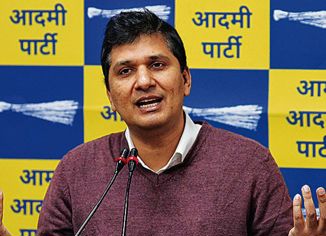
engineering innovation: With over 35,000 colleges in the country offering more than 100 streams, there is little to stop engineering students from flying high
B.S. Satyanarayana
In spite of the emergence of several new career choices, engineering remains a favourite among Indian students. The main reason for the popularity of this stream is the high profile success of several Indians overseas. These include Sunder Pichai, Satya Nadella, Rajiv Suri, Vinod Khosla, Vinod Dham and many more. Of late, this has been supplemented by success stories in India too — the e commerce industry is just one example. Several companies in this sector have been promoted by engineers. India was the third largest recipient of private equity and venture capital funding in 2015 ($7 billion) and a very large proportion of this funding is going into ventures promoted by engineers.
It is now a widely accepted truism that to emerge as a global power, India can no longer depend on growth in services alone. Manufacturing will need to play a key role and hence the emphasis on "Make in India" by Prime Minister Narendra Modi. This emphasis on manufacturing is likely to increase the demand for engineers in at least six broad areas.
- The first will be ICT-enabled areas such as cloud computing, high performance computing, analytics, mobility, policy, social media and security. The field of Artificial Intelligence is just one of the major fields that would come under the scope of this area.
- The second will cover aspects such as emerging materials, advanced & additive manufacturing, integrated networks enabled automation and surface engineering. The field of additive manufacturing or 3 D printing, in particular, is likely to see explosive growth. Newer materials such as glass are being used and even larger parts such as those that go into aircraft mainframes are being manufactured using this method. By speeding up and reducing the cost of prototyping, 3 D printing will continue to benefit new product development.
- The third broad area will be that of the environment, sustainability, water, waste management and clean air. Efficient utilisation of fresh water, in particular, will be a big challenge. Demand is increasing with increased population growth and finite supplies are dwindling rapidly with over exploitation of aquifers.
- The fourth area will be that of clean and renewable energy as well as energy efficiency. There is now an irreversible trend all over the world to move from energy derived from fossil fuels to that derived from cleaner sources such as wind and solar.
- The fifth area will cover aspects such as large area microelectronics, plastic and printable (flexible) electronics and surface engineering. This will cover the Internet of Things where increasingly all kinds of devices and appliances will be connected and have the ability to talk to one another.
- The last area will pertain to fields such as sensors, health, instrumentation, networks and embedded systems. We are looking at advances such that a large proportion of mankind will easily be able to live well beyond a century.
Pitfalls to avoid
But while the future demand for engineers looks very promising, the reality today is that, by common consensus, 60 to 75 per cent of them are unemployable. And many of the brightest ones move on to other fields such as the MBA or Civil Services. Why is this so?
A major reason is that engineering students in the first year in most colleges are not exposed to engineering in the true sense. They end up studying the same physics, chemistry and mathematics that they did in school. There is no clarity on why this practice is being followed in most of the engineering colleges.
In India, many students go through extensive preparation spread over many years in school to get into a good engineering college. Often they are so "burnt-out" by the time they enter college that they are unable to do justice to their engineering studies. That is a mistake. While some degree of relaxation is fine, students should realise that mere entry into a good engineering college is not good enough. Their future depends on how well they perform in college. The ideal combination is to take studies seriously and take up a hobby for relaxation.
A common mistake that many students make is to think that engineering is one unified discipline. If they get into a good engineering college, they usually tend to opt for the most popular discipline available. That’s not a good idea since the skills required in different engineering disciplines are different. For example, a mechanical engineer should be comfortable working with his own hands on different tools and implements. A biomedical engineer needs to have greater empathy with suffering patients. An electronics and communication engineer should enjoy coding. And so on.
With over a 100 streams and specialisations to choose from engineering has become a hugely versatile option for students. In addition to the conventional civil, electrical and mechanical streams, avenues have opened for those interested in courses in many more hybrid branches. Many of these new disciplines involve knowledge of subjects not traditionally associated with engineering such as biology. Some of the new disciplines include ceramic engineering, environmental engineering, agriculture engineering, dairy engineering, mechatronics, etc.
In a growing economy like India, where infrastructure is growing at a phenomenal pace, challenging opportunities are going to open for decades to come and this is what makes engineering an exciting and promising career option.
The writer is Pro-Vice-Chancellor, BML Munjal University, Gurgaon
B.S. Satyanarayana
In spite of the emergence of several new career choices, engineering remains a favourite among Indian students. The main reason for the popularity of this stream is the high profile success of several Indians overseas. These include Sunder Pichai, Satya Nadella, Rajiv Suri, Vinod Khosla, Vinod Dham and many more. Of late, this has been supplemented by success stories in India too — the e commerce industry is just one example. Several companies in this sector have been promoted by engineers. India was the third largest recipient of private equity and venture capital funding in 2015 ($7 billion) and a very large proportion of this funding is going into ventures promoted by engineers.
It is now a widely accepted truism that to emerge as a global power, India can no longer depend on growth in services alone. Manufacturing will need to play a key role and hence the emphasis on "Make in India" by Prime Minister Narendra Modi. This emphasis on manufacturing is likely to increase the demand for engineers in at least six broad areas.
n The first will be ICT-enabled areas such as cloud computing, high performance computing, analytics, mobility, policy, social media and security. The field of Artificial Intelligence is just one of the major fields that would come under the scope of this area.
n The second will cover aspects such as emerging materials, advanced & additive manufacturing, integrated networks enabled automation and surface engineering. The field of additive manufacturing or 3 D printing, in particular, is likely to see explosive growth. Newer materials such as glass are being used and even larger parts such as those that go into aircraft mainframes are being manufactured using this method. By speeding up and reducing the cost of prototyping, 3 D printing will continue to benefit new product development.
n The third broad area will be that of the environment, sustainability, water, waste management and clean air. Efficient utilisation of fresh water, in particular, will be a big challenge. Demand is increasing with increased population growth and finite supplies are dwindling rapidly with over exploitation of aquifers.
n The fourth area will be that of clean and renewable energy as well as energy efficiency. There is now an irreversible trend all over the world to move from energy derived from fossil fuels to that derived from cleaner sources such as wind and solar.
n The fifth area will cover aspects such as large area microelectronics, plastic and printable (flexible) electronics and surface engineering. This will cover the Internet of Things where increasingly all kinds of devices and appliances will be connected and have the ability to talk to one another.
n The last area will pertain to fields such as sensors, health, instrumentation, networks and embedded systems. We are looking at advances such that a large proportion of mankind will easily be able to live well beyond a century.
Pitfalls to avoid
But while the future demand for engineers looks very promising, the reality today is that, by common consensus, 60 to 75 per cent of them are unemployable. And many of the brightest ones move on to other fields such as the MBA or Civil Services. Why is this so?
A major reason is that engineering students in the first year in most colleges are not exposed to engineering in the true sense. They end up studying the same physics, chemistry and mathematics that they did in school. There is no clarity on why this practice is being followed in most of the engineering colleges.
In India, many students go through extensive preparation spread over many years in school to get into a good engineering college. Often they are so "burnt-out" by the time they enter college that they are unable to do justice to their engineering studies. That is a mistake. While some degree of relaxation is fine, students should realise that mere entry into a good engineering college is not good enough. Their future depends on how well they perform in college. The ideal combination is to take studies seriously and take up a hobby for relaxation.
A common mistake that many students make is to think that engineering is one unified discipline. If they get into a good engineering college, they usually tend to opt for the most popular discipline available. That’s not a good idea since the skills required in different engineering disciplines are different. For example, a mechanical engineer should be comfortable working with his own hands on different tools and implements. A biomedical engineer needs to have greater empathy with suffering patients. An electronics and communication engineer should enjoy coding. And so on.
With over a 100 streams and specialisations to choose from engineering has become a hugely versatile option for students. In addition to the conventional civil, electrical and mechanical streams, avenues have opened for those interested in courses in many more hybrid branches. Many of these new disciplines involve knowledge of subjects not traditionally associated with engineering such as biology. Some of the new disciplines include ceramic engineering, environmental engineering, agriculture engineering, dairy engineering, mechatronics, etc.
In a growing economy like India, where infrastructure is growing at a phenomenal pace, challenging opportunities are going to open for decades to come and this is what makes engineering an exciting and promising career option.
The writer is Pro-Vice-Chancellor, BML Munjal University, Gurgaon
What college has in store for you
The scourge of ragging has been more or less eradicated and there is strict punishment for offenders. However attendance requirements are quite strict.
There will be more girl students than there were in the past.
There will be a repeat of physics, chemistry and maths studied in Class XII. However, there will also be a fair emphasis on experiential learning.
Another change a student can expect is greater emphasis on skill and perspective courses. To succeed as an engineer, technical knowledge alone is not enough. So colleges now have courses on selling and negotiating skills.
It is also important for students to have an appreciation of the big, overall picture through courses such as world civilisations.
Biomedical engineering
It involves design of instruments, devices, and software, to bring together knowledge from many technical sources to develop new procedures or to conduct research needed to solve clinical problems. A biomedical engineer uses the traditional engineering theory and techniques to analyse and solve problems in biology and medicine providing an overall enhancement of healthcare.
The course curriculum in biomedical engineering covers subjects such as clinical engineering, tissue and genetic engineering, biomechanics, medical imaging, rehabilitation engineering, system physiology, bio-mechanics, bio-materials etc. These methods are applied in medical health treatment.
Who should go for it: Students should choose the biomedical engineering field if they wish to be of service to people, to partake of the excitement of working with living systems, and to apply advanced technology to the complex problems of medical care.
Work profile: A biomedical engineer will need to work with other persons not traditionally connected with engineering such as healthcare professionals, including physicians, nurses, therapists and technicians.
Top Engineering colleges
PEC University of Technology, Chandigarh
www.pec.ac.in
Seats: 385 for BTech.
USP: Rated among the top 10 institutes other than IITs. At present there are 11 post-graduate courses leading to master’s degree in Highways, Structures, Hydraulics and Irrigation, Rotodynamic Machines.
Thapar University, Patiala
www.thapar.edu
Seats: 760 for BE/BTech.
USP: One of the oldest private universities in the country, its 250-acre campus, consists of Thapar University, Thapar Polytechnic and Thapar Centre for Industrial Research and Development.
Lovely Professional University, Jalandhar
www.lpu.in
Seats: 2,000
USP: Among the largest private universities in the northern region, it has a strong industry connect and international twinning programmes for engineering students.
Chandigarh University (UIET), Gharaun
www.cuchd.in
Seats: 2800
USP: Awarded with Asia’s Fastest Growing and Best University for Engineering. Industry tie-ups with IBM, Microsoft, Mahindra & Mahindra, Volvo-Eicher, Tech-Mahindra, Wipro, Oracle and Infosys have established their Research & Development Labs on the campus.
Indian Institute of Technology Ropar
www.iitrpr.ac.in
Seats: 40 in each branch
USP: Ranked 9 among engineering colleges in India Ranking 2016
University of Petroleum and Energy Studies (UPES), Dehradun
www.upesindia.org
Seats: 60 seats in each stream
USP: Offers a wide spectrum of globally competitive undergraduate, postgraduate and doctorate programs in Energy, Infrastructure and Transportation (EIT) and other growth sectors.
J P University of Information Technology, Waknaghat, Solan
www.juit.ac.in
Seats: E&C 120, Com Sc 60, biotechnology.30, Civil 60, bioinformatics 30
USP: Accredited by NAAC and NBA. JUIT provides a learner-centric rather than a teacher-centric educational process. Projects worth Rs 10 crore are underway in the university .
— Based on selected lists from national surveys
Emerging specialisations
Materials engineering
This branch deals with the study of differed materials that are used in our day to day life. A cross between engineering and science, this field of study allows students to study and develop new materials for new applications besides improving the existing materials for better performance. As material experts they are able to control the struture of a material on an atomic level to tailor its properties to suit a definite application. The new or improved engineered material can spark an entirely new invention or industry.
Oil & Petroleum engineering
This branch of engineering has become popular over the past few years due to increasing job prospects in India as well as abroad. Petroleun engineers not only design equipment to maximise the recovery of oil and gas, but also use computer tech to simulate reservoir performance using different recovery techniques. They also work in tandem with geologists to understand properties of rock for better drilling procedures. The B. Tech Applied Petroleum Engineering programme trains students in petroleum engineering and focuses on exploration and production of oil & gas.
Instrumentation engineering
Instrumentation engineering deals with instruments and development of different instruments used in household (thermostat), automotive (airbag), aircraft (inertial navigation systems), laboratory instrumentation and many more to mention. It’s a vast field that is growing exponentially. Nature of work that is involved is designing and developing of new control systems, maintaining and modifying existing systems and improving productivity, safety, and stability. An instrumentation engineer can seek jobs in manufacturing plants, R &D units and heavy industries like thermal power stations, steel plants, refineries, cement.



























